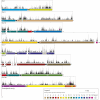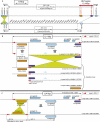Comparative genomics of citric-acid-producing Aspergillus niger ATCC 1015 versus enzyme-producing CBS 513.88
- PMID: 21543515
- PMCID: PMC3106321
- DOI: 10.1101/gr.112169.110
Comparative genomics of citric-acid-producing Aspergillus niger ATCC 1015 versus enzyme-producing CBS 513.88
Abstract
The filamentous fungus Aspergillus niger exhibits great diversity in its phenotype. It is found globally, both as marine and terrestrial strains, produces both organic acids and hydrolytic enzymes in high amounts, and some isolates exhibit pathogenicity. Although the genome of an industrial enzyme-producing A. niger strain (CBS 513.88) has already been sequenced, the versatility and diversity of this species compel additional exploration. We therefore undertook whole-genome sequencing of the acidogenic A. niger wild-type strain (ATCC 1015) and produced a genome sequence of very high quality. Only 15 gaps are present in the sequence, and half the telomeric regions have been elucidated. Moreover, sequence information from ATCC 1015 was used to improve the genome sequence of CBS 513.88. Chromosome-level comparisons uncovered several genome rearrangements, deletions, a clear case of strain-specific horizontal gene transfer, and identification of 0.8 Mb of novel sequence. Single nucleotide polymorphisms per kilobase (SNPs/kb) between the two strains were found to be exceptionally high (average: 7.8, maximum: 160 SNPs/kb). High variation within the species was confirmed with exo-metabolite profiling and phylogenetics. Detailed lists of alleles were generated, and genotypic differences were observed to accumulate in metabolic pathways essential to acid production and protein synthesis. A transcriptome analysis supported up-regulation of genes associated with biosynthesis of amino acids that are abundant in glucoamylase A, tRNA-synthases, and protein transporters in the protein producing CBS 513.88 strain. Our results and data sets from this integrative systems biology analysis resulted in a snapshot of fungal evolution and will support further optimization of cell factories based on filamentous fungi.
Figures



References
-
- Alexa A, Rahnenführer J, Lengauer T 2006. Improved scoring of functional groups from gene expression data by decorrelating GO graph structure. Bioinformatics 22: 1600–1607 - PubMed
-
- Aparicio S, Chapman J, Stupka E, Putnam N, Chia JM, Dehal P, Christoffels A, Rash S, Hoon S, Smit A, et al. 2002. Whole-genome shotgun assembly and analysis of the genome of Fugu rubripes. Science 297: 1301–1310 - PubMed
Publication types
MeSH terms
Associated data
- Actions
- Actions
- Actions
- Actions
- Actions
- Actions
- Actions
- Actions
- Actions
- Actions
- Actions
- Actions
- Actions
- Actions
- Actions
- Actions
- Actions
- Actions
- Actions
- Actions
- Actions
- Actions
- Actions
- Actions
- Actions
- Actions
- Actions
- Actions
- Actions
- Actions
- Actions
- Actions
- Actions
- Actions
- Actions
- Actions
- Actions
- Actions
- Actions
- Actions
- Actions
- Actions
- Actions
- Actions
- Actions
- Actions
- Actions
- Actions
- Actions
- Actions
- Actions
- Actions
- Actions
- Actions
- Actions
- Actions
LinkOut - more resources
Full Text Sources
Other Literature Sources
Molecular Biology Databases
Miscellaneous
